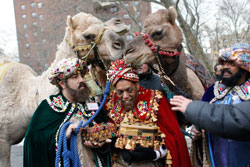As with every year, before the last piece of turkey is carved, everyone is out shopping for the holiday season. Even though different holidays have finally made their way into the spotlight, there are still several celebrations or holiday traditions that not many people know about.
Sophomore Ashtin Brinkerhoff, for instance, who lived in the town of Rota, Spain for seven years celebrates Three Kings Day, which pays respects to the Magi who brought Jesus presents in the manager. “Anywhere you went in Spain, it would [look] the same [because of celebration] along with religious music compared to the usual American Christmas carols. There are several similarities. For example, you can sit on the Three Kings’ laps, and instead of leaving carrots and cookies out for Santa and the reindeer, you leave out hay and water for the camels,” she explained. “We still exchange gifts of Christmas Eve, but we get our main gifts from the Three Kings on Dec. 6.”
Then there are the more popular holidays such as Chanukah, which is the festival of lights celebrated by those who practice Judaism. Each night, a candle is lit as a symbol of the eight nights that the oil burned in the temple. In modern times, some have created their own traditions based off this ancient ritual.
“When my children were little, they both went to Jewish pre-school. During Chanukah, one of the projects they did in school was making their own menorah,” said Sherry Sukienik, an adjunct communication professor. “I have four or five homemade menorahs made out of wood or clay, and we started the tradition of alternating the menorahs. My children are grown and out of the house, but I still use the ones they made as children.”
Then there are those who celebrate multiple holidays like sophomore Ross Ottoman who celebrates both Christmas and Chanukah. “If they are around the same time, like last year, we will celebrate them a day apart. If they are the same day, we will celebrate both holidays together, but usually we give each one a specific day or days.”
Along with the main holidays, there are those that also celebrate the winter solstice, which occurs around Dec. 21. The origin of this holiday dates back to ancient times and means “sun stands still” and marks the beginning of the winter with the shortest day of year.
This natural phenomenon led to the creation of traditions that celebrate the “rebirth” of sunlight. The ancient Romans observed this holiday as Saturnalia with a weeklong feast, where gifts were exchanged and masters would wait on servants during meals as a sign of equality. All this was done to pay homage to Saturn, the roman god of sowing.
Later on, it became a pagan holiday where the group would still celebrate with feasts, but it also started the tradition of bringing evergreen trees indoors and decorating them with candles as a sign of tribute to the sun.
One of the newest winter holidays is Kwanzaa, or “First Fruits” which was created in 1966. This holiday was created by Dr. Maulana Karenga who wanted to reinforce the seven principles of the African American Culture which are unity, self-determination, collective work and responsibility, cooperative economics, purpose, creativity and faith. The main purpose of the holiday is similar to Chanukah and Christmas. It reaffirms the bonds between people and shows the best of the African culture. The idea of the “First Fruit” holiday goes back in history as far as ancient Egypt, and was slowly dying out until Karenga brought the idea of Kwanzaa to the U.S.
So whether you have a Christmas tree, Menorah, or camel as your decoration, there is one common theme that can be noticed among all these holidays. It is not about what you celebrate, but rather how and who you are with.
“It represents family time, and creating traditions for my children they way my parents did for me,” Sukienik added. “It’s the whole idea of being together, and it doesn’t have to be about the huge lavish gifts. It’s more important to be with one another and share what we are grateful for.”
IMAGE TAKEN from huffingtonpost.com




